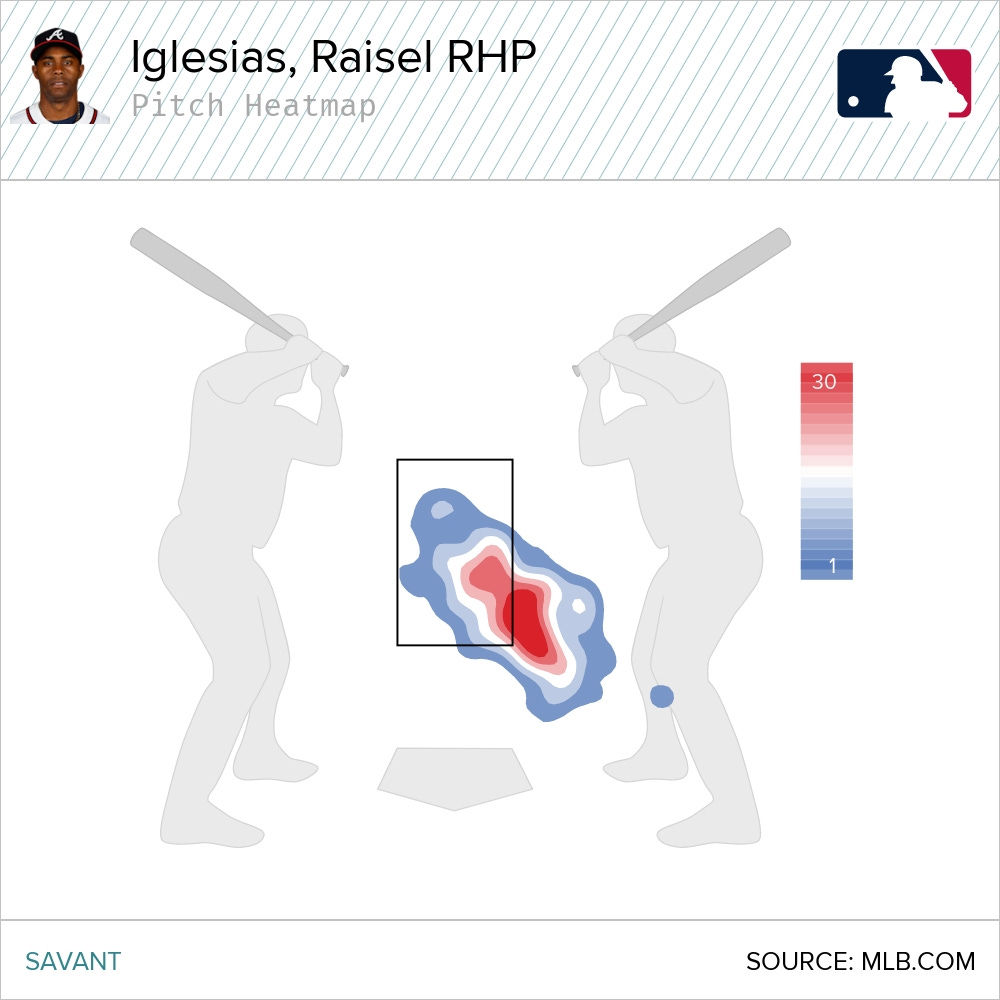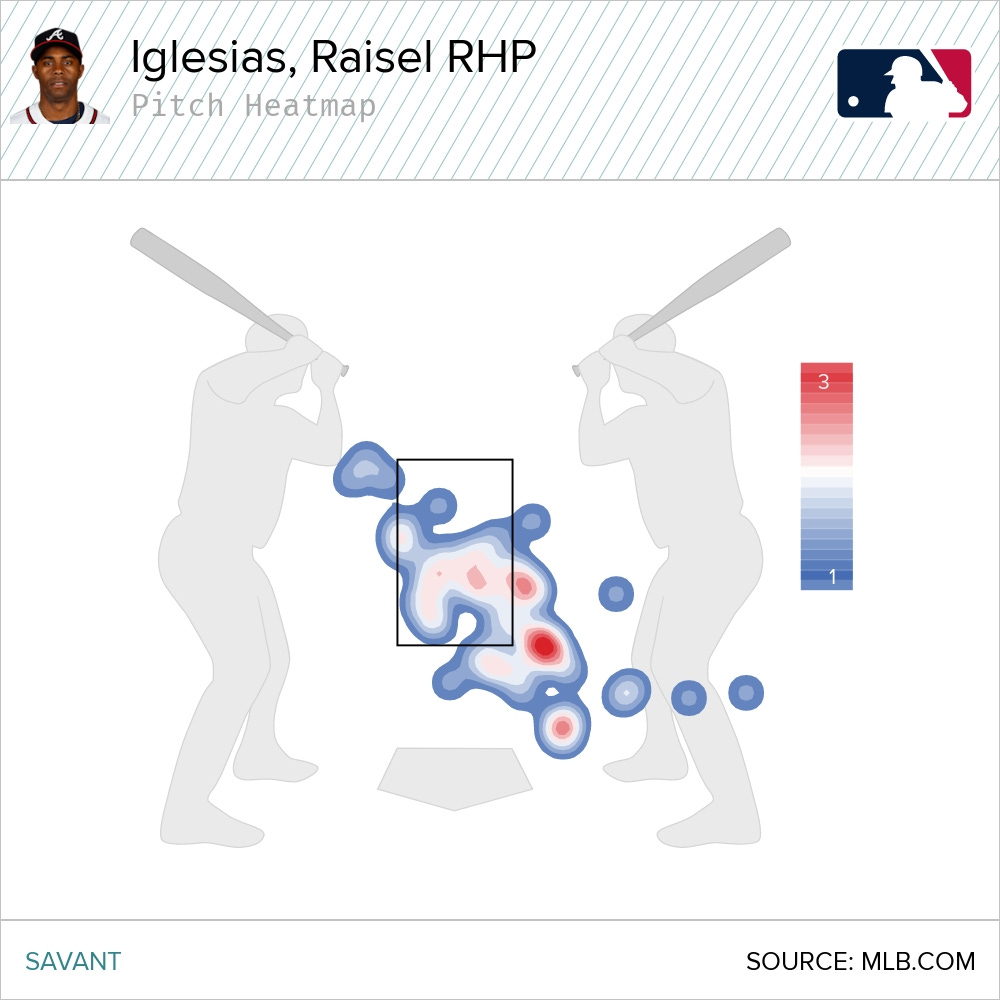What is wrong with Raisel Iglesias' slider?
Atlanta's incumbent closer has a career worst ERA, mostly because of giving up home runs
Raisel Iglesias was one of MLB’s best closers last year. Finishing with a career-best 1.95 ERA and 34 saves, his 2.9 WAR was tied for 5th among relievers with St. Louis Cardinals closer Ryan Helsley.
This year is…different. Iglesias’ ERA is a career-worst 5.75, and it’s mostly earned. His Fielding Independent Pitching is 6.22, while his Expected ERA on Statcast is only marginally better than his actual ERA at 5.40.
Most concerning is his impact on the team’s win-loss record. After blowing just four saves last year (and the Braves still winning two of those games), he’s already blown three this year. Thankfully, Atlanta’s held on to win two of those games in extras, but his four losses are already more than he had all of last season, when he finished 6-2.
Manager Brian Snitker isn’t concerned on the whole, but he is making some changes.
“They haven’t been terrible outings,” Snitker told the media, including the AJC’s Olivia Sayer. “It’s just been one pitch. We’re not looking to get away from that because the stuff’s there.”
That ‘one pitch’ is Iglesias’ slider, which has already allowed five homers off of it this season, more than he allowed in the entirety of 2024 on all of his pitches (4). The Braves have a plan for it…sort of.
“We’re probably going to need to adjust his pitch selection,” Snitker said. “Because other than that, he’s throwing the ball really well. It’s just that his slider hasn’t been real good. The ones he throws bad, he’s not getting back.”
What is wrong with the slider and how can Atlanta fix it? Let’s talk about it.
Just how bad has the slider been?
Really bad.
In 2024, Iglesias allowed a .163 average and .279 slug, good for a .195 wOBA on the slide piece. 31 of them were put into play (out of 192 thrown), resulting in five singles, one triple, and one homer. The expected stats show that this performance was mostly earned, with an xBA of .153, an xSLG of .252, and a xwOBA of .183.
This year? A .583 BA, 1.833 SLG, and a wOBA of 1.013. Yes there’s some bad luck here, but even the expected stats are bad: .419 xBA, 1.463 xSLG, and .771 xwOBA.
Of the 51 thrown, nine have been put into play. Two outs, two singles, and five homers.
But why is it so bad?
Is it the locations?
That’s part of it.
Here’s the heat map for 2024, showing that Iggy mostly likes to take this out of the zone for chase.
Even when it does stay in the zone, it’s not being hit hard…with the exception of the lone homer last year on it, a center-cut slider that Teoscar Hernández of the Dodgers absolutely launched into the stratosphere.
This season, it’s in the zone…roughly the same amount.
Out of 192 sliders thrown in 2024, Iggy left 87 of them in the zone, a rate of 45%.
Out of 51 sliders thrown in 2025, Iggy left 22 of them in the zone, a rate of 43%.
Interestingly, the whiff rate on these is roughly the same, as well, being 22.2% last year and 21.1% this year.
Well, maybe it’s the pitch being elevated? Let’s check that, too.
Of those 87 in-zone sliders in 2024, 49 of them were in the middle or top of the zone1, usually not where you want to leave those unless it’s on the black. That’s 56.32% of them.
Of those 22 in-zone sliders in 2025, 13 of them were in the middle or top of the zone. That’s 59.09%, functionally the same as last year.
So it can’t all be on locations, even though a few of the homers he’s allowed on the pitch HAVE been from subpar locations.2
But while the frequency of being in the zone is roughly the same between seasons, the results are absolutely not the same. In-zone sliders for Iglesias last year had a .161 batting average (.161 xBA) and .323 slug (.298 xSLG). This year? .667 batting average (.541 xBA) and 2.333 slug (1.925 xSLG).
I think I might have figured it out.
The slider itself isn’t different…most of the time
Iggy’s slider is roughly the same movement profile as last year - above-average horizontal movement (+4.1 inches gloveside) with below-average drop (-3.1 inches). It has lost some drop this year, though, going from -2.3 inches below-average last year to this year’s -3.1. The horizontal movement hasn’t changed, still sitting at 10.8 inches gloveside movement, but the rest of the league has shifted to more horizontal movement on sliders and so it’s now not as big of an outlier (only +4.1 inches over average) as it was last year (+4.9 inches over average).
But it is different, and the changes come at the worst time.
The sliders that have resulted in homers feature even less vertical and horizontal movement than the ones that aren’t. In essence, he throws a bad pitch. A cement mixer, if you will.
Again, his usual: 35.3 inches vertical drop, 10.8 inches gloveside
Homered sliders: 33.6 inches vertical drop, 9.5 inches gloveside
And that missing movement, usually the horizontal, is what ends up doing him in.
Here’s a homer from Trea Turner on April 9th. Notice how Sean Murphy’s setup on the outer third but the ball doesn’t entirely get there?
Same here on the Willson Contreras homer from April 21st. Outer third location but the ball never gets there.
Rece Hinds on April 8th? Same story - this is supposed to be off the plate and it just never gets there.
Here’s one to Manny Machado over the weekend that’s both lower and farther inside than Murphy wanted it.
It’s not just righties that he’s doing that to. Here’s one that is supposed to be inside to lefty Jonathan Aranda and he leaves it a little more towards the middle of the plate than Murph wanted it.
Listen: Most pitchers are going to miss spots. That’s part of being a pitcher. For the longest time, the Tampa Bay Rays directed their minor league catchers to set up right down the middle on every pitch, knowing that the natural movement of the ball and a pitcher’s inherent variability of locations would usually take the ball out of the center of the zone.3
But I’d argue that these ‘misfires’, for lack of a better term, almost universally feature less horizontal movement than expected, which leaves the ball in a more hittable location. They seem to be more prevalent this season than they were last, which goes back to how Iglesias throws the pitch.
From Olivia’s article again:
“It’s a little bit of a feel pitch with him,” catcher Drake Baldwin told The Atlanta-Journal Constitution. “He has such a good sinker and 4-seam and changeup with that slider, just to get away from righties, is something that he’s used in the past, and it’s worked really well. This year, it’s not where it was in the past, so practically, (going) heavier on the changeup and 4-seam.”
Changeups are usually referred to as the ultimate feel pitch, but not every pitcher’s the same. I’d wager a guess that Iggy’s a pronator, so he’s more comfortable throwing fastballs and off-speed pitches, and he’s battling his natural motor preferences to throw a slider.
Supinators are breaking ball masters due to their ability to get outside of the ball and impart spin, but pronators excel at getting inside the ball, meaning their changeups have natural arm-side run. Iggy’s changeup reminds me of Luis Castillo’s, and both pitchers feature sinkers and four-seamers to create a sort of triangle on a pitch plot. Castillo’s slider is a better version of Iggy’s, though, being a true gyro slider with late drop on it.
At this point, can you teach a 35-year-old dog new tricks? I don’t know, but there’s a path to being successful with less slider usage. Adjusting how it’s called - eliminate the targets in the upper half of the zone and concentrate it down at the bottom or below the zone - would be beneficial, as well as using it more to steal strikes in unexpected counts instead of a primary whiff pitch would be the path I’d take as of now.
Do I think Iglesias can be a good closer without a slider? It’s a bit unusual but he can. The question is will he be?
Attack zones 1-6
Of the five homers, three of them were in the middle third of the zone, with the final two being center-cut but in the bottom third of the zone.
Also, during this time, they leaned heavily into north-south profiles among their arms, a great example of the player acquisition and development teams working hand-in-hand.





